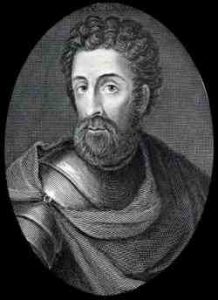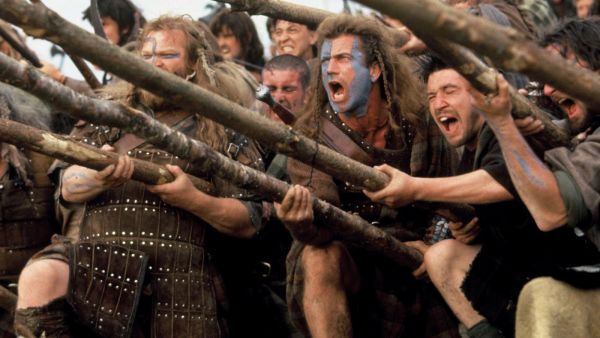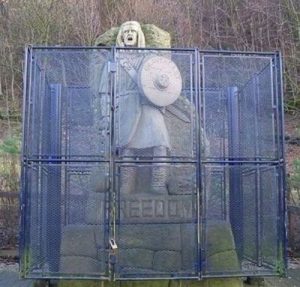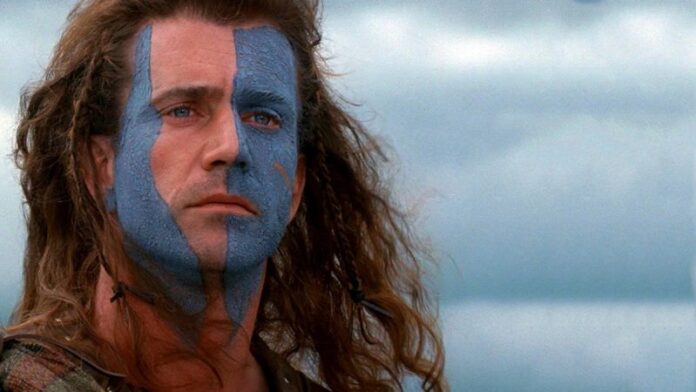Braveheart (1995): Directed By Mel Gibson / Country: USA / Starring: Mel Gibson, Sophie Marceau, Patrick McGoohan.
Mel Gibson’s Braveheart is full-blood medieval action movie based on life and death of Scottish national hero William Wallace, Scottish personal Che Guevara. Braveheart won five Oscars including for Best Picture and best Makeup, but Oscar for Best Costume Design went to less famous movie Restoration. The Braveheart has returned glorious historical spectacles on a menu, however, it is questioned how much this movie is historical.
William Wallace as real person

William Wallace was a real person, yet about him, there is a little-known information. After death he became a legend which further helped to misleading information; English chroniclers called him Malleus Anglicorum, the hammer of England. It is assumed that he was born between 1260 and 1278, no one knows where, although the city of Elderslie claims that he have that the honour. He was raised in a time when Scotland was in peace with its southern neighbour, the England. He was Lowlander of gentle though not noble parents. His father was a landholder who was probably a knight, and his mother was probably a knight’s daughter. Family background affected on his political program; his aim was to restore the throne of the dethroned King of Scotland John Balliol, who was a prisoner of the English King Edward I of England, aka Edward Longshanks and the Hammer of the Scots. The idea that he was a freedom fighter is completely unfounded. He never said he fought for the rights of ordinary Scottish people.
Battles
Wallace led Scots with Andrew Moray, fellow colleague Guardian of Scotland in an uprising. On 11 September 1297, the forces of Andrew Moray and William Wallace defeated the combined English forces with cunning tactic; they waited for English troops to cross a narrow Stirling Bridge and attacked them when their numbers were still beatable. Divided into two sides of river English troops never stood a chance. Some historians question belief that Wallace was not a tactician of that victory, and credit Andrew Moray for a tactic. Battle of Stirling Bridge and aftermaths were a peak of Wallace’s career. After that, he didn’t win any battle but he lost Battle of Falkirk and spent seven years abroad. After the return to Scotland, he was betrayed by his own people and was caught, dragged to London where he was tortured and killed.
Best source – A Song
Most of the things that we take for granted about William Wallace actually come from a single song: The Acts and Deeds of the Illustrious and Valiant Champion Sir William Wallace from Blind Harry. The song was created 170 years after the death of Wallace, and in the romantic and patriotic way talks about his life; the story was loaded with love, loss and revenge. How much we can rely on that song if Wallace is described as a gigantic man of two meters, but at the beginning of the story says that Wallace once dressed up as a woman to avoid arresting from English soldiers and succeeded in that intention.
It is also questionable whether Wallace even got married, let alone that she died at the hands of Englishmen. According to some, the death of a close person, wife, lover or family member may have made him eager for vengeance, but to some similarity of his wife name with Sherwood’s Marian is really evidence of creating Robin Hood look-alike myth. The song The blind Harry Wallace is what it is; romantic epic fiction.

Other sources do not tell much; one source has a detailed description of his physical appearance; needless to say, Indian look-alike, Mel Gibson’s version does not resemble at all to real Wallace. According to some information screenwriter, Randall Wallace got the idea when he saw the monuments Wallace and Robert the Bruce in Edinburgh while he was on vacation. Only after scenario was written they have added small details such as historical facts.
Farm boy or Knight
The first sentence of the film pretentious claims: Historians from England will say I am a liar, but history is written by those Who have hanged heroes. If we believe so this is a film with an exceptional view of the historical accuracy of focusing on sensitive English and Scot history, but truth is not out there.
Wallace is shown as a child born peasant and whose family was killed early on so his uncle took him to Europe to study. Truth is that Wallace was born into a wealthier family, a landowner family. He was born as the second child and was probably sent to Europe to study for a priest because the old laws in which the entire inheritance fell into the hands of the eldest son. During Wallace’s childhood England and Scotland are not at war, therefore the slaughter of his family entirely fictional event in order to raise the drama.
The Return of medieval model
With the return from Europe, we see a new Wallace; Indian look-alike with a huge lousy wig and a three-day beard. It is fascinating that he maintains that beard whole movie despite the fact that half a movie he fought a guerrilla war. Probably he managed to find a time to shave on some mountain well and did a good job of never to cut himself. Shaving has certainly lasted longer because the rest of the body was not hairy too. Trough entire movie watch too white and too clean teeth, both at Wallace and others characters. In peasant medieval period that is not possible; throughout the history, they have had much worse teeth because of a diet high in starch and without much meat.
Among the bearded and fat Scots, Gibson’s Wallace looks like a superhero, therefore, no wonder that manages to cut off people’s limbs, even through chain mail with a one sword blow.
Scottish pride filmed in Ireland
The shooting of the film has begun in Scotland, but they quickly noticed that the rain makes it difficult to film and the location was transferred to Ireland so that landscape is not like those locations where the actual events took place. Scenes of nature indeed look great, everything is green, muddy and wet, and to be one from a medieval movie.

Battle scenes were also filmed in Ireland, which does not justify that the Battle of Stirling Bridge has no bridge in sight. A stunning victory of tactical deception and one bridge replaced the tactics in the open field and the use of tactical wits. Wallace’s army was portrayed as a bunch of peasants, although in reality, it was well organised and disciplined army. Instead of the bridge, we got paint on faces (Woad), which have no place in this period. That is an anachronism from the period 1000 years before the action of the film takes place. It would be interesting to know whether out of time paint on the faces helped the gain The Academy Award for Best Makeup. There is another eye-catching anachronism; kilts which do not belong in this period but are 500 years early.
Good VS Evil
Overdramatizing the story created almost pure good vs evil conflict: on the one hand, we have Edward Longshanks, who is more like Darth Vader in the medieval period, with his soldiers who all look the same, as Starship Troopers, while on the other hand, we have Scottish rebels. Edward at the beginning of the movie immediately makes it clear that the on evil side and introduces a right of the first night to attract the English nobilities in Scotland. It is difficult to prove that this right existed, let alone that the royal decree carried official law. In addition, Eduard is doing much more evil things that would not ashamed even Dart Vader: kills lover of his son, shoots arrows in battle on his own soldiers because they are mixed with enemies, he uses the princess as bait to protracted negotiations and dragged a new army and so on.
The only two people who hover between the two sides as Robert the Bruce and Princess Isabella. Robert the Bruce actually shows the complexity of real-life story; you can lose all by complete switch-over to one side. As a character Robert the Bruce was also a fail; he was not a Scotsman, but a nobleman who spoke French and had estates in France, Scotland and England, and during the Battle of Falkirk he was miles away. Princess Isabella is an even worse case because at the time of Wallace’s death she was 10 years old and lived in France.
The moral of the story is; Edward wanted English blood in Scotland, but actually got Scottish blood on English throne.
Conclusion
The first sentence of the film is the worst crime because viewers think that everything in the movie is exactly as it happened in real life. Anyone without knowledge of Scottish history could easily think that everything in the film shows the truth, and what is perhaps different from the actual history is actually a confirmation of the rule that history is written up by a winner. No face paints, no kilts, or historical inaccuracies can be compared to the crime of that first sentence.
Braveheart is a dramatic film that has nothing to do actual history. If he had stayed within the limits of the Blind Harry’s song he would had more to do with history. The film actually wanders between history and myth, taking from each the best he can; this is an area that brings the most money. Some Scots take the movie as a truth, while others take it as a disgrace. The truth about the movie tells a Gibson’s statue as Wallace erected in near Stirling who had to be protected to avoid being damaged by angry Scots.

Braveheart is one of the few Hollywood movies that deal with the subject without a happy ending, at least not for the life of the main character. Instead of the happy end, we got Wallace’s blood on English throne and all-American message: FREEDOM (if you reading this in Mel Gibson voice maybe you have watch this movie too often).
If something is good about history in Braveheart it is showing the formation of legends and stories even during Wallace’s lifetime. Braveheart makes a crime against history, but If it is accepted as pure fiction, as Mad Max, then, is a solid action.
Worst Sins:
- Face paint Woad is on face of warriors but it hasn’t been used around 1000 years
- Battle at Stirling bridge without bridge at sight
- Always clean, with healthy teeth and 3 days beard
- Fictional relationship with Isabella



[…] stories about individual who fight bad system because he wants to help his community and country (Braveheart, etc.). In this movie, we have ideal Gibson’s hero; a fierce believer (Of course he is a […]